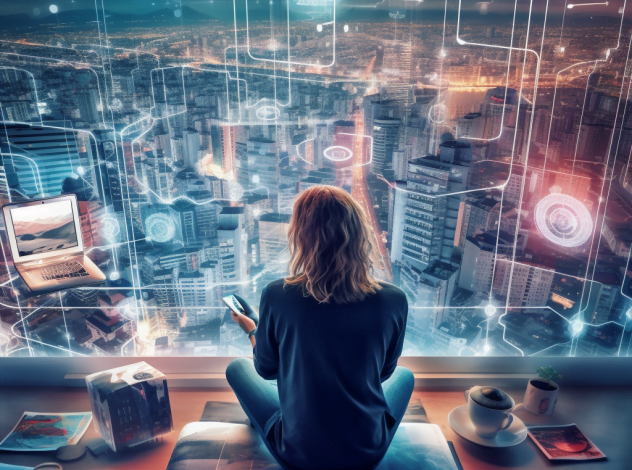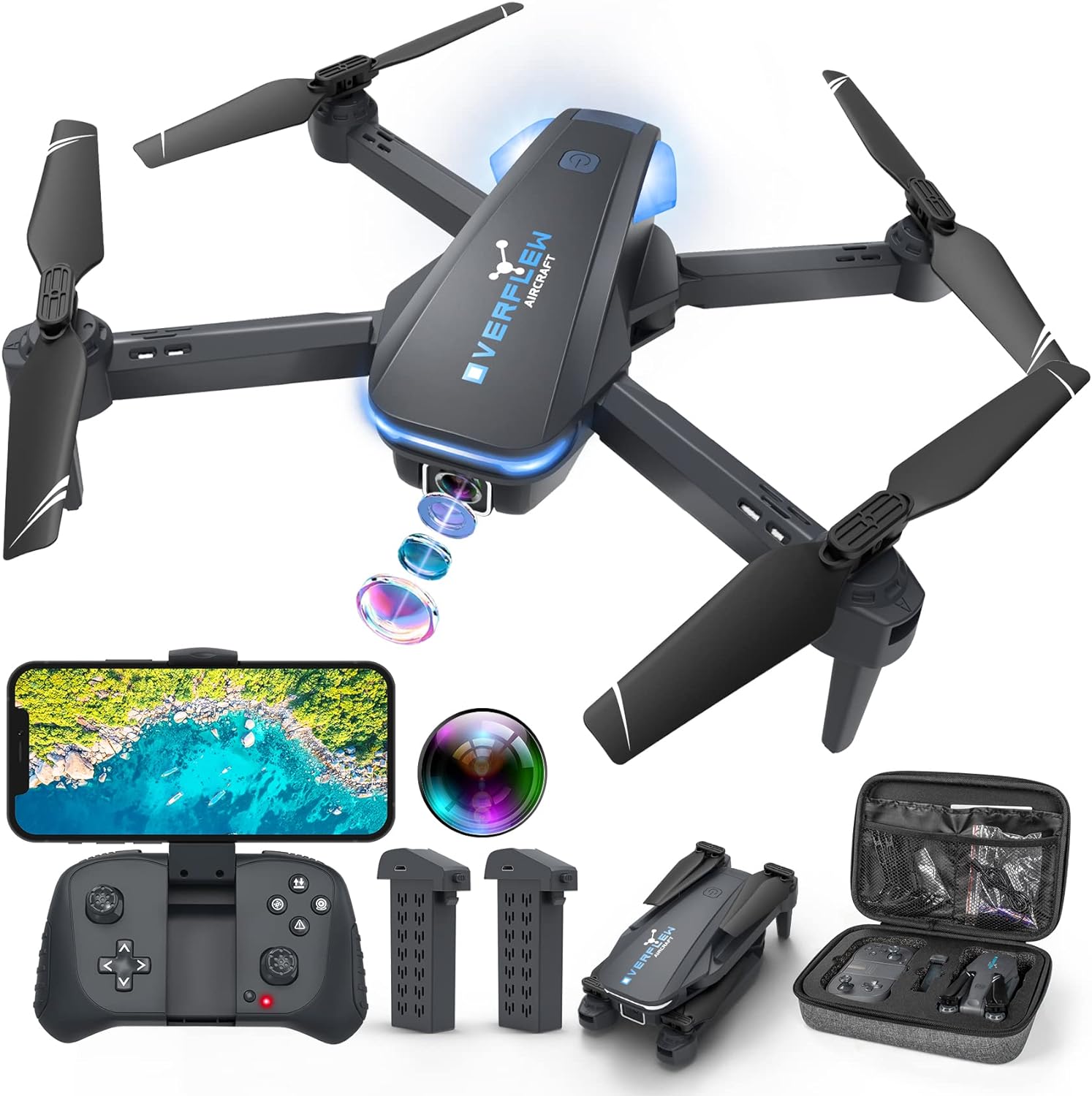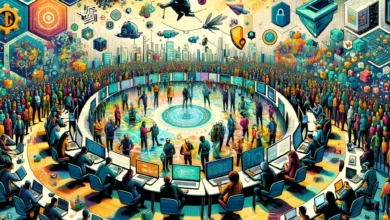A Connected Future: How the Internet of Things is Shaping our World
Dive into the world of IoT and its potential to revolutionize industries and enhance our daily lives

The Internet of Things (IoT) represents an epochal shift in the world of technology, paving the way for a world where devices communicate seamlessly with each other over the Internet. By harnessing this interconnected web of devices, we stand on the brink of transforming industries, business operations, and the fabric of daily life. This article will guide you through the dynamic landscape of IoT, highlighting its transformative power and potential implications.
Why IoT Matters:
- Boosted Efficiency: IoT harnesses real-time data, offering insights that streamline processes, highlight the need for preventive maintenance, and promote resource allocation optimization.
- Informed Decisions: The wealth of data generated by IoT devices provides granular insights. This information is crucial for businesses and individuals, enabling strategic planning and smarter decision-making.
- Smart Living: From homes that adjust the lighting based on our mood to cities that optimize traffic flow during rush hours, IoT is the driving force behind the smart environments of the future.
- Revolutionizing Healthcare: Be it through remote monitoring of patients or refining drug development processes, IoT applications in healthcare are bound to redefine patient care and medical research.
- The Advent of Industry 4.0: IoT is the backbone of the fourth industrial revolution, synergizing machines, sensors, and processes to craft an intelligent, self-sustaining manufacturing ecosystem.
Crucial Commands in the IoT Ecosystem:
- Device Set-Up: Commands that focus on the initial configuration of IoT devices, ensuring they are network-compatible, secure, and primed for efficient data transmission.
- Harvesting Data: Commands dedicated to extracting and processing intricate data details, such as environmental parameters or the intricate metrics of machine performance.
- Diving into Data: Commands that channel the power of analytics, mining raw data to surface actionable insights and discernible patterns.
- Mastering Device Management: From troubleshooting issues remotely to ensuring optimal performance via firmware updates, these commands ensure your IoT devices are always at their peak.
- Fortifying Security: These commands prioritize the security of IoT devices, encompassing everything from intricate encryption techniques to multifaceted intrusion detection systems.
Harnessing IoT: Tips, Tricks, and Real-world Applications:
- Championing Interoperability: Guarantee smooth communication between diverse IoT devices by adhering to established industry standards.
- The Power of Edge Computing: Process data at the source. This reduces latency and offers insights in real time, allowing for rapid, informed decisions.
- Guarding Data Privacy: Beyond just encryption, ensure you have clear user consent mechanisms, reinforcing trust in your IoT ecosystem.
- Eco-friendly IoT: From intelligent scheduling to energy-efficient transmission protocols, ensure your IoT devices are green and optimized for minimal power consumption.
- Marrying IoT with AI: Leverage artificial intelligence and machine learning to enhance the capabilities of your IoT devices, creating a smart, adaptive, and predictive network.
Real-world Success Stories:
- Smart Farming: Agriculture has witnessed a renaissance with the advent of IoT. Farms today use IoT-enabled sensors to monitor soil moisture levels, ensuring optimal irrigation. This not only conserves water but also ensures maximum crop yield. For instance, John Deere tractors now have sensors that can precisely plant seeds at the most effective depth and spacing and even measure soil fertility.
- Wearable Health Devices: Fitness trackers like Fitbit or the Apple Watch use IoT to monitor health metrics such as heart rate, sleep patterns, and activity levels. These devices can provide early warnings for potential health issues and help doctors monitor patients in real-time.
- Smart Cities: Barcelona, a forerunner in the smart city race, uses IoT for traffic management, waste management, and even street lighting. Their smart lighting system adjusts the intensity based on the presence of pedestrians, traffic, or public events, leading to significant energy savings.
Potential Challenges with IoT:
- Security Concerns: With billions of devices connected, ensuring each device’s security becomes challenging. Breaches can lead to significant data leaks, impacting both individuals and businesses.
- Data Overload: The sheer volume of data generated by IoT devices can be overwhelming. Sorting, analyzing, and deriving meaningful insights from this data require advanced data management solutions and strategies.
- Interoperability: As more manufacturers enter the IoT space, ensuring their devices can communicate and function seamlessly with devices from other manufacturers becomes a pressing concern.
Forecasting the Future of IoT:
- Billions More Devices: Gartner predicts that by 2025, over 75 billion IoT devices will be active globally. This surge will be fueled by advancements in 5G technology, providing faster and more reliable connections.
- IoT in Healthcare: The future will likely see more sophisticated health-monitoring devices, from smart contact lenses that can detect blood sugar levels to ingestible sensors that can provide a detailed analysis of the digestive system.
- Autonomous Vehicles: Cars will not only be smarter but, with the help of IoT, they will communicate with other vehicles, predict maintenance, and even interact with traffic signals.
- Personalized Retail Experience: Imagine walking into a store where the environment adjusts based on your preferences. From changing room lighting to alerting you to items on sale that match your taste, IoT will redefine the shopping experience.
Let’s delve deeper into the socio-economic impacts and ethical implications of the Internet of Things (IoT) world.
Socio-Economic Impacts of IoT:
- Job Creation and Transformation: The expansion of IoT leads to the creation of new job roles, such as IoT specialists, IoT security analysts, and data scientists. At the same time, it may cause obsolescence in some traditional roles. Thus, continuous upskilling becomes necessary.
- Urbanization and Smart Cities: As cities become smarter with IoT, urban areas might become more attractive due to enhanced efficiency and quality of life. This could result in increased urbanization, leading to challenges in housing and infrastructure.
- Enhanced Productivity: Automated processes and real-time data analysis can significantly boost efficiency in industries, leading to increased production rates at reduced costs.
- Economic Disparities: While developed countries might ride the first wave of IoT benefits, underdeveloped regions without the necessary infrastructure might lag, potentially widening the global economic divide.
- Consumer Behavior Shift: As IoT introduces new ways of interaction and commerce (like automated replenishment of groceries or predictive maintenance alerts), businesses will need to adapt to changing consumer behaviors to stay competitive.
Ethical Implications of IoT:
- Privacy Concerns: The interconnected nature of IoT devices means they continuously generate and share data. Who has access to this data and how it’s used is a significant concern. For instance, is it ethical for an insurance company to adjust premiums based on data from a person’s fitness tracker?
- Surveillance and Control: Government bodies or large corporations might exploit the pervasive nature of IoT for surveillance, leading to potential infringements on individual freedoms and rights.
- Dependence on Technology: As homes, cities, and industries become more interconnected, there’s a risk of over-reliance on technology. A massive failure in such a system, whether from a cyber-attack or a technical glitch, could have catastrophic consequences.
- E-waste: The proliferation of IoT devices can lead to an increase in electronic waste. The ethical concern lies in the sustainable disposal and recycling of these devices.
- Bias and Discrimination: As more decisions are made based on IoT data and analytics, there’s a risk of algorithms inheriting biases present in their training data, leading to discriminatory outcomes.
In Conclusion:
The future painted by the Internet of Things is undoubtedly one of promise, a canvas of increased efficiency, connectivity, and innovation. However, this future is nuanced. While the socio-economic benefits, like job creation and enhanced productivity, stand out, we must also navigate the challenges, such as economic disparities and changing job landscapes. Ethically, the IoT treads a fine line. The conveniences offered come with strings attached — concerns of privacy, surveillance, and the environmental impact of e-waste. As we stand on the cusp of this IoT-dominated era, it’s paramount to strike a balance. By addressing the challenges head-on, promoting transparency, and fostering a culture of continuous learning and adaptation, we can ensure that the future of IoT is not only technologically advanced but also inclusive, ethical, and truly beneficial for all.





